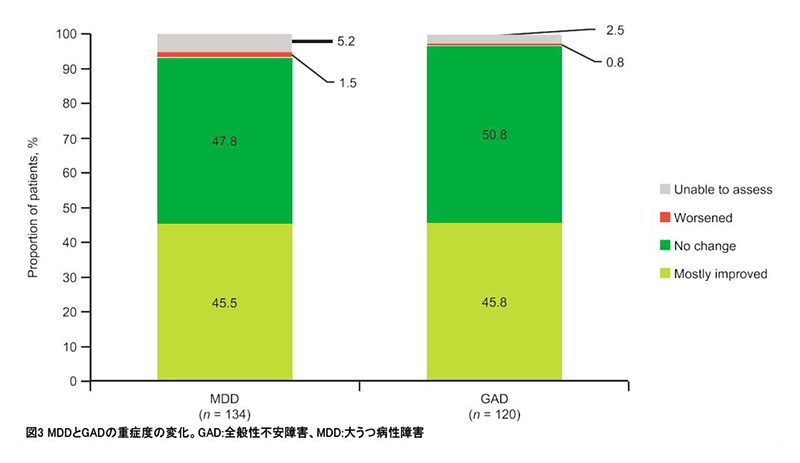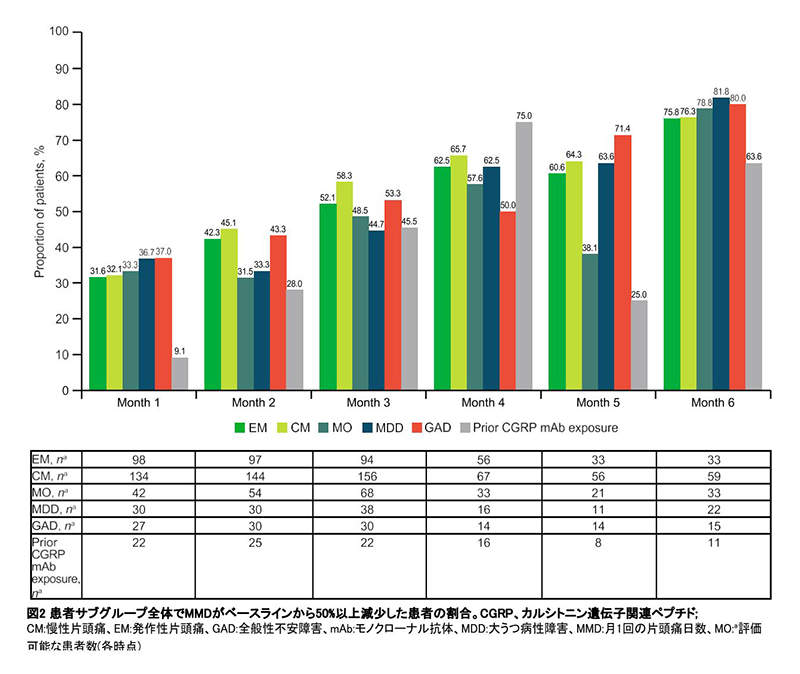うつ病、適応障害等を合併している頭痛
当院に通院中の片頭痛患者様にも多くの方が精神疾患であるうつ病、適応障害、躁うつ病等を併発しているケースがあります。
疫学的研究において、片頭痛における大うつ病の年間有病率は約8.6%、生涯有病率は18~40%程度と報告され、片頭痛をもたない群と比較してうつ病の生涯有病率は2~4倍高くなるとされています。片頭痛と不安症との関連についてはパニック症のほか、全般性不安症、恐怖症、強迫症があります。
うつ病と同様に、パニック症においても3.76倍罹患しやすく、前兆のある片頭痛で随伴しやすいとされております。
当院では通院加療にて頭痛日数、疼痛を改善しております。一度ご相談ください。
- 片頭痛患者様の10人に1人はうつ病を合併している事がある
- うつ病や適応障害を合併している片頭痛患者様でもCGPR製剤はよく効く
片頭痛や緊張型頭痛では、不安や抑うつを伴いやすく、また精神疾患としてうつ病や不安症(パニック症など)を伴うことも多い。これらの精神状態や精神疾患の共存は、頭痛の慢性化の要因となり、また日常生活支障度の悪化につながるとされています。
片頭痛や緊張型頭痛に随伴しやすい精神疾患として抑うつ性障害(うつ病)、双極性障害、薬物依存症、不安症(パニック症、全般性不安症、恐怖症)が挙げられる。特に片頭痛とうつ病およびパニック症との関連については、いずれもセロトニンの代謝異常が発症に関与している点で注目されている。
疫学的研究において、片頭痛における大うつ病の年間有病率は約8.6% 1)、生涯有病率は18~40%程度と報告され、片頭痛をもたない群と比較してうつ病の生涯有病率は2~4倍高くなる 2-7)。片頭痛と不安症との関連についてはパニック症のほか、全般性不安症、恐怖症、強迫症が検討されている。うつ病と同様にパニック症においても、3.76倍罹患しやすく、前兆のある片頭痛で随伴しやすい 1,3,7-10)。こうした精神疾患と片頭痛との関連性については、片頭痛と精神疾患との関連性を高める因子として、前兆があること、慢性化していること、薬物乱用の傾向があることが報告されている 14)。
緊張型頭痛における心理社会的要因や精神疾患との関連性についての研究は、片頭痛よりも少ない。
心理社会的ストレスおよび不安・抑うつなどの心理状態との関連性が指摘され、精神疾患の共存に関しては片頭痛と同様にうつ病、不安症(パニック症、全般性不安症)、強迫症、身体症状症が報告されている 11,12,15)。
一次性頭痛に精神疾患が共存することによって、慢性化へつながり 16)、日常生活への支障度が悪化し17)、自殺へのリスクが高まる 18,19)。
これまでの報告のほとんどが一次性頭痛と不安や抑うつの関連性を指摘しているが、心理状態または精神疾患の評価法が一定しておらず、関連性が高い理由について、セロトニンの関与が想定されているが、統一された見解はまだない。
1)Jette N, Patten S, Williams J, et al:Comorbidity of migraine and psychiatric disorders:a national population-based study. Headache 2008;48(4):501-516.
2)Antonaci F, Nappi G, Galli F, et al:Migraine and psychiatric comorbidity:a review of clinical findings. J Headache Pain 2011;12(2):115-125.
3)Breslau N, Davis GC, Andreski P:Migraine, psychiatric disorders, and suicide attempts:an epidemiologic study of young adults. Psychiatry Res 1991;37(1):11-23.
4)Breslau N, Schultz LR, Stewart WF, et al:Headache and major depression:is the association specific to migraine? Neurology 2000;54(2):308-313.
5)Mitsikostas DD, Thomas AM:Comorbidity of headache and depressive disorders. Cephalalgia 1999;19(4):211-217.
6)Swartz KL, Pratt LA, Armenian HK, et al:Mental disorders and the incidence of migraine headaches in a community sample:results from the Baltimore Epidemiologic Catchment area follow-up study. Arch Gen Psychiatry 2000;57(10): 945-950.
7)Amoozegar F:Depression comorbidity in migraine. Int Rev Psychiatry 2017;29(5):504-515.
8)Stewart W, Breslau N, Keck PE Jr:Comorbidity of migraine and panic disorder. Neurology 1994;44(10 Suppl 7): S23-27.
9)Breslau N, Schultz LR, Stewart WF, et al:Headache types and panic disorder:directionality and specificity. Neurology 2001;56(3):350-354.
10)Smitherman TA, Kolivas ED, Bailey JR:Panic disorder and migraine:comorbidity, mechanisms, and clinical implica- tions. Headache 2013;53(1):23-45.
14)Radat F, Swendsen J:Psychiatric comorbidity in migraine:a review. Cephalalgia 2005;25(3):165-178.
15)Holroyd KA, Stensland M, Lipchik GL, et al:Psychosocial correlates and impact of chronic tension-type headaches. Headache 2000;40(1):3-16.
16)Ashina S, Bendtsen L, Buse DC, et al:Neuroticism, depression and pain perception in migraine and tension-type headache. Acta Neurol Scand 2017;136(5):470-476.
17)Ayele BA, Yifru YM:Migraine-related disability and co-morbid depression among migraineurs in Ethiopia:a cross-sec-tional study. BMC Neurol 2018;18(1):95.
18)Calati R, Courtet P, Norton J, et al:Association between lifetime headache and history of suicide attempts in the elderly. Eur Psychiatry 2017;41:132-139.
19)Seo JG, Kim KT, Moon HJ, et al:Suicidality and its risk factors in tension-type headache patients:a multicenter case-control study. J Clin Neurosci 2019;69:21-25.
RWE USの論文報告
フレマネズマブが、下記疾患を併存してもしっかり効果が出るというデータ
① 薬物使用過多の片頭痛(MOH)
② 大うつ病
③ 全般性不安障害
④ 他のCGRP製剤(エムガルティ、アイモビーク)からのスイッチ
Real-world effectiveness after initiating fremanezumab treatment in US patients with episodic and chronic migraine or difficult-to-treat migraine
背景
フレマネズマブは、カルシトニン遺伝子関連ペプチド(CGRP)を選択的に標的とする完全ヒト化モノクローナル抗体(mAb; IgG2)であり、成人の片頭痛の予防的治療に承認されている。片頭痛予防のためのフレマネズマブの有効性と安全性は、無作為化二重盲検プラセボ対照試験で実証されている。 臨床試験データを補完するには、実世界の有効性データが必要である。本研究では、実臨床現場で、エピソード性片頭痛(EM)、慢性片頭痛(CM)、または治療困難(DTT)片頭痛の成人患者の異なるサブグループにわたるフレマネズマブの有効性を評価した。
方法
この遡及的、パネルに基づくオンラインカルテレビューは、電子症例報告書を使用した。 患者の選択基準は、EMまたはCMの医師による診断。初回開始から1回目のフォローアップ来院;および月1回の片頭痛日数の2回の測定(MMD;1回は初回開始前または初回開始時に1ヶ月以内、初回開始後に1回)。頭痛日数の変化と月次頭痛日数を追跡期間中に評価した。
これらの評価項目は、片頭痛のタイプ別(EM/CM)およびDTT片頭痛のサブグループ(薬物過剰使用の診断[MO]、大欠乏性障害[MDD]、全般性不安障害[GAD]、または異なるCGRP経路標的mAb[CGRP mAb]への過去の曝露)において評価した。
結果
データは、421人の臨床医と1,003人の患者から収集した。
結論
このリアルワールド研究において、フレマネズマブは、片頭痛型またはDT片頭痛に寄与する因子(薬物使用過多、大うつ病、全般性不安障害、または異なるCGRP mAbへの以前の曝露)の存在にかかわらず、片頭痛に対する有効性を実証した。
The Journal of Headache and Pain
https://doi.org/10.1186/s10194-022-01415-x
院長 山田による要約
アメリカでの1,003名のフレマネズマブ(アジョビ)を投与した患者さんのデータの解析になります。サブ解析にて、① 薬剤使用過多、② 大うつ病、③ 全般性不安障害、④ 他のCGRP製剤使用歴の患者様でも頭痛の改善を示したデータです。


当院でも多くの頭痛患者様が、うつ病、全般性不安障害、適応障害等の精神疾患を併発しており受診しております。
CGRP製剤を使用して上記疾患の患者様でも著名に頭痛日数が減っているので、精神疾患併存の場合でも臆することなくCGRPが導入できる良いデータです。
Improvement of comorbid anxiety and depression in patients with migraine treated with injectable preventive calcitonin gene-related peptide antagonists: Review of clinical evidence
予防的カルシトニン遺伝子関連ペプチド拮抗薬の注射による片頭痛患者の併存する不安とうつ病の改善:臨床証拠のレビュー
背景
片頭痛はしばしばうつ病および不安と関連し、生活の質の低下につながる。カルシトニン遺伝子関連ペプチド(CGRP)拮抗薬は片頭痛の治療に有望であることが示されているが、うつ病および不安を同時に発生に対する効果は明らかにされていない。
方法
過去5年間に発表された第3相臨床試験、事後解析試験、実世界エビデンス(RWE)を中心に、ClinicalTrials.gov, PubMed, Ovid Medline,EMBASEについて文献レビューを行った。このレビューでは、主に患者報告アウトカムツール、例えば患者健康質問票-9、ハミルトンうつ病評価尺度、ベックうつ病評価尺度-II、全般性不安障害(GAD)-7、ハミルトン不安評価尺度(HARS)を利用して、CGRP標的モノクローナル抗体に関連した不安およびうつ病を評価した。
結果
260件の研究のうち、17件が対象基準を満たしました。エプチネズマブには、うつ病や不安症への影響に関する十分な証拠がありませんでした。併存する不安に対するその効果に関する十分な証拠は入手できなかったが、ある研究ではフレマネズマブが併存するうつ病を有意に改善することが示されたが、別の研究では統計的有意性は得られなかった。エレヌマブとガルカネズマブは併存するうつ病の大幅な改善を示し、片頭痛患者に効果がある可能性を示唆しています。ガルカネズマブは、他の注射可能なCGRP抗体薬よりも早いうつ病症状の軽減を示しました。
ガルカネズマブは、統計的に有意ではないものの、不安に対するGAD-7スコアの改善も示しましたが、RWE はガルカネズマブとエレヌマブの両方で有望な HARS スコアを示しました。
結論
ガルカネズマブとエレヌマブは、片頭痛患者におけるうつ病と不安の同時症状の改善において、フレマネズマブよりも効果的であると考えられます。
引用文献
- Ashina M., Saper J., Cady R., Schaeffler B.A., Biondi D.M., Hirman J., Pederson S., Allan B., Smith J. Eptinezumab in episodic migraine: A randomized, double-blind, placebo-controlled study (PROMISE-1) Cephalalgia. 2020;40:241–254. doi: 10.1177/0333102420905132.
- Bell C.C. DSM-IV: diagnostic and statistical manual of mental disorders. JAMA. 1994;272:828. doi: 10.1001/jama.1994.03520100096046.
- Bobo W.V., Angleró G.C., Jenkins G., Hall-Flavin D.K., Weinshilboum R., Biernacka J.M. Validation of the 17-item Hamilton Depression Rating Scale definition of response for adults with major depressive disorder using equipercentile linking to Clinical Global impression scale ratings: analysis of Pharmacogenomic Research Network Antidepressant Medication Pharmacogenomic Study (PGRN-AMPS) data. Hum. Psychopharmacol. 2016;31:185–192. doi: 10.1002/hup.2526.
- Breslau N., Davis G.C., Andreski P. Migraine, psychiatric disorders, and suicide attempts: an epidemiologic study of young adults. Psychiatry Res. 1991;37:11–23. doi: 10.1016/0165-1781(91)90102-u.
- Burch R.C., Buse D.C., Lipton R.B. Migraine: epidemiology, burden, and comorbidity. Neurol. Clin. 2019;37:631–649. doi: 10.1016/j.ncl.2019.06.001.
- Buse D.C., Silberstein S.D., Manack A.N., Papapetropoulos S., Lipton R.B. Psychiatric comorbidities of episodic and chronic migraine. J. Neurol. 2013;260:1960–1969. doi: 10.1007/s00415-012-6725-x.
- Clark D.B., Donovan J.E. Reliability and validity of the Hamilton anxiety rating scale in an adolescent sample. J. Am. Acad. Child Adolesc. Psychiatry. 1994;33:354–360. doi: 10.1097/00004583-199403000-00009.
- Cohen F., Yuan H., Silberstein S.D. Calcitonin gene-related peptide (CGRP)-targeted monoclonal antibodies and antagonists in migraine: current evidence and rationale. BioDrugs. 2022;36:341–358. doi: 10.1007/s40259-022-00530-0.
- Detke H.C., Goadsby P.J., Wang S., Friedman D.I., Selzler K.J., Aurora S.K. Galcanezumab in chronic migraine: the randomized, double-blind, placebo-controlled REGAIN study. Neurology. 2018;91:e2211. doi: 10.1212/WNL.0000000000006640.
- Dodick D.W., Ashina M., Brandes J.L., Kudrow D., Lanteri-Minet M., Osipova V., Palmer K., Picard H., Mikol D.D., Lenz R.A. ARISE: A Phase 3 randomized trial of erenumab for episodic migraine. Cephalalgia. 2018;38:1026–1037. doi: 10.1177/0333102418759786.
- Ferrari M.D., Diener H.C., Ning X., Galic M., Cohen J.M., Yang R., Mueller M., Ahn A.H., Schwartz Y.C., Grozinski-Wolff M., Janka L., Ashina M. Fremanezumab versus placebo for migraine prevention in patients with documented failure to up to four migraine preventive medication classes (FOCUS): a randomised, double-blind, placebo-controlled, phase 3b trial. Lancet. 2019;394:1030–1040. doi: 10.1016/S0140-6736(19)31946-4.
- Fuller-Thomson E., Jayanthikumar J., Agbeyaka S.K. Untangling the association between migraine, pain, and anxiety: examining migraine and generalized anxiety disorders in a Canadian population based study. Headache. 2017;57:375–390. doi: 10.1111/head.13010.
- García-Batista Z.E., Guerra-Peña K., Cano-Vindel A., Herrera-Martínez S.X., Medrano L.A. Validity and reliability of the beck depression inventory (BDI-II) in general and hospital population of Dominican Republic. PLOS ONE. 2018;13:e0199750.
- Goadsby P.J., Reuter U., Hallström Y., Broessner G., Bonner J.H., Zhang F., Sapra S., Picard H., Mikol D.D., Lenz R.A. A controlled trial of erenumab for episodic migraine. N. Engl. J. Med. 2017;377:2123–2132. doi: 10.1056/NEJMoa1705848.
- Guidetti V., Galli F., Fabrizi P., Giannantoni A.S., Napoli L., Bruni O., Trillo S. Headache and psychiatric comorbidity: clinical aspects and outcome in an 8-year follow-up study. Cephalalgia. 1998;18:455–462. doi: 10.1046/j.1468-2982.1998.1807455.x.
- Ho T.W., Edvinsson L., Goadsby P.J. CGRP and its receptors provide new insights into migraine pathophysiology. Nat. Rev. Neurol. 2010;6:573–582. doi: 10.1038/nrneurol.2010.127.
- Ho T.W., Connor K.M., Zhang Y., Pearlman E., Koppenhaver J., Fan X., Lines C., Edvinsson L., Goadsby P.J., Michelson D. Randomized controlled trial of the CGRP receptor antagonist telcagepant for migraine prevention. Neurology. 2014;83:958–966. doi: 10.1212/WNL.0000000000000771.
- Irimia P., Garrido-Cumbrera M., Santos-Lasaosa S., Aguirre-Vazquez M., Correa-Fernández J., Colomina I., Pozo-Rosich P. Impact of monthly headache days on anxiety, depression and disability in migraine patients: results from the Spanish Atlas. Sci. Rep. Atlas Press. 2021;11:8286. doi: 10.1038/s41598-021-87352-2.
- Jette N., Patten S., Williams J., Becker W., Wiebe S. Comorbidity of migraine and psychiatric disorders—a national population-based study. Headache. 2008;48:501–516. doi: 10.1111/j.1526-4610.2007.00993.x.
- Kroenke K., Spitzer R.L., Williams J.B.W. The PHQ-9: validity of a brief depression severity measure. J. Gen. Intern. Med. 2001;16:606–613. doi: 10.1046/j.1525-1497.2001.016009606.x.
- Kudrow D., Cady R.K., Allan B., Pederson S.M., Hirman J., Mehta L.R., Schaeffler B.A. Long-term safety and tolerability of eptinezumab in patients with chronic migraine: a 2-year, open-label, phase 3 trial. BMC Neurol. 2021;21:126. doi: 10.1186/s12883-021-02123-w.
- Lampl C., Kraus V., Lehner K., Loop B., Chehrenama M., Maczynska Z., Ritter S., Klatt J., Snellman J. Safety and tolerability of erenumab in individuals with episodic or chronic migraine across age groups: a pooled analysis of placebo-controlled trials. J. Headache Pain. 2022;23:104. doi: 10.1186/s10194-022-01470-4.
- Lantéri-Minet M., Radat F., Chautard M.H., Lucas C. Anxiety and depression associated with migraine: influence on migraine subjects’ disability and quality of life, and acute migraine management. Pain. 2005;118:319–326. doi: 10.1016/j.pain.2005.09.010.
- Lipton, R.B., Bigal, M.E., Diamond, M., Freitag, F., Reed, M.L., Stewart, W.F., AMPP Advisory Group, 2007. Migraine prevalence, disease burden, and the need for preventive therapy. Neurology. 68, 343–349. 10.1212/01.wnl.0000252808.97649.21.
- Lipton R.B., Cohen J.M., Galic M., Seminerio M.J., Yeung P.P., Aycardi E., Bigal M.E., Bibeau K., Buse D.C. Effects of fremanezumab in patients with chronic migraine and comorbid depression: subgroup analysis of the randomized HALO CM study. Headache. 2021;61:662–672. doi: 10.1111/head.14097.
- Lucas C., Lantéri-Minet M., Massiou H., Nachit-Ouinekh F., Pradalier A., Mercier F., El Hasnaoui A., Radat F. The GRIM2005 study of migraine consultation in France ii. Psychological factors associated with treatment response to acute headache therapy and satisfaction in migraine. Cephalalgia. 2007;27:1398–1407. doi: 10.1111/j.1468-2982.2007.01446.x.
- Maier W., Buller R., Philipp M., Heuser I. The Hamilton Anxiety Scale: reliability, validity and sensitivity to change in anxiety and depressive disorders. J. Affect. Disord. 1988;14:61–68. doi: 10.1016/0165-0327(88)90072-9.
- Maizels M., Buse D.C., Jedynak J., Hand A.L., Ford J., Detke H. Changes in depression and anxiety in a randomized, double-blind, placebo-controlled study of galcanezumab in adults with treatment-resistant migraine: results from the CONQUER study (1383) Neurology. 2020;94(15):1383.
- Merrill R.M., Gibbons I.S. Comorbidity of sleep disorders, mental illness, and migraine or headaches. SN Comprehensive Clinical Medicine. 2023;5(1):283. doi: 10.1007/s42399-023-01622-w.
- Mitsikostas D.D., Alexoudi A., Arvaniti C., Giannouli E., Kouremenos Ε., Constantinidis T.S., Hellenic Headache S. Hellenic Headache Society Recommendations for the Use of Monoclonal Antibodies Targeting the Calcitonin Gene-Related Peptide Pathway for the Prevention of Migraine and Cluster Headache—2023 Update. SN Comprehensive Clinical Medicine. 2023;5(1):118. doi: 10.1007/s42399-023-01452-w.
- O’Sullivan R.L., Fava M., Agustin C., Baer L., Rosenbaum J.F. Sensitivity of the six-item Hamilton Depression Rating Scale. Acta Psychiatr. Scand. 1997;95:379–384. doi: 10.1111/j.1600-0447.1997.tb09649.x.
- Petersen K.A., Birk S., Lassen L.H., Kruuse C., Jonassen O., Lesko L., Olesen J. The CGRP-antagonist, BIBN4096BS does not affect cerebral or systemic haemodynamics in healthy volunteers. Cephalalgia. 2005;25:139–147. doi: 10.1111/j.1468-2982.2004.00830.x.
- Pozo-Rosich P., Detke H.C., Wang S., Doležil D., Li L.Q., Aurora S.K., Reuter U. Long-term treatment with galcanezumab in patients with chronic migraine: results from the open-label extension of the REGAIN study. Curr. Med. Res. Opin. 2022;38:731–742. doi: 10.1080/03007995.2022.2059975.
- Russo A., Silvestro M., Scotto Di Clemente F., Trojsi F., Bisecco A., Bonavita S., Tessitore A., Tedeschi G. Multidimensional assessment of the effects of erenumab in chronic migraine patients with previous unsuccessful preventive treatments: A comprehensive real-world experience. J. Headache Pain. 2020;21:69. doi: 10.1186/s10194-020-01143-0.
- Sacco S., Amin F.M., Ashina M., Bendtsen L., Deligianni C.I., Gil-Gouveia R., Lampl C. European Headache Federation guideline on the use of monoclonal antibodies targeting the calcitonin gene related peptide pathway for migraine prevention – 2022 update. The Journal of Headache and Pain. 2022;23(1):67. doi: 10.1186/s10194-022-01431-x.
- Schiano di Cola F., Caratozzolo S., Liberini P., Rao R., Padovani A. Response predictors in chronic migraine: medication overuse and depressive symptoms negatively impact onabotulinumtoxin-a treatment. Front. Neurol. 2019;10:678. doi: 10.3389/fneur.2019.00678.
- Schim J.D., Anderson C., Brunner E., Hirman J., Ogbru A., Cady R., McGill L. Likelihood of response with subsequent dosing for patients with migraine and initial suboptimal response with eptinezumab: A post hoc analysis of two placebo-controlled randomized clinical trials. Headache. 2022;62:558–565. doi: 10.1111/head.14302.
- Seo J.G., Park S.P. Validation of the Generalized Anxiety Disorder-7 (GAD-7) and GAD-2 in patients with migraine. J. Headache Pain. 2015;16:97. doi: 10.1186/s10194-015-0583-8.
- Seo J.G., Park S.P. Validation of the Patient Health Questionnaire-9 (PHQ-9) and PHQ-2 in patients with migraine. J. Headache Pain. 2015;16:65. doi: 10.1186/s10194-015-0552-2.
- Sharp R. The Hamilton rating scale for depression. OCCMED. 2015;65:340. doi: 10.1093/occmed/kqv043.
- Silvestro M., Tessitore A., Orologio I., De Micco R., Tartaglione L., Trojsi F., Tedeschi G., Russo A. Galcanezumab effect on “whole pain burden” and multidimensional outcomes in migraine patients with previous unsuccessful treatments: a real-world experience. J. Headache Pain. 2022;23:69. doi: 10.1186/s10194-022-01436-6.
- Skljarevski V., Matharu M., Millen B.A., Ossipov M.H., Kim B.K., Yang J.Y. Efficacy and safety of galcanezumab for the prevention of episodic migraine: results of the EVOLVE-2 Phase 3 randomized controlled clinical trial. Cephalalgia. 2018;38:1442–1454. doi: 10.1177/0333102418779543.
- Spitzer R.L., Kroenke K., Williams J.B.W., Löwe B. A brief measure for assessing generalized anxiety disorder: the GAD-7. Arch. Intern. Med. 2006;166:1092–1097. doi: 10.1001/archinte.166.10.1092.
- Stauffer V.L., Dodick D.W., Zhang Q., Carter J.N., Ailani J., Conley R.R. Evaluation of galcanezumab for the prevention of episodic migraine: the EVOLVE-1 randomized clinical trial. JAMA Neurol. 2018;75:1080–1088. doi: 10.1001/jamaneurol.2018.1212.
- Talbot J., Stuckey R., Crawford L., Weatherby S., Mullin S. Improvements in pain, medication use and quality of life in onabotulinumtoxinA-resistant chronic migraine patients following erenumab treatment – real world outcomes. J. Headache Pain. 2021;22:5. doi: 10.1186/s10194-020-01214-2.
- Wang Y.P., Gorenstein C. Psychometric properties of the Beck Depression Inventory-II: A comprehensive review. Braz J Psychiatry. 2013;35:416–431. doi: 10.1590/1516-4446-2012-1048.
- Williams J.B.W. Standardizing the Hamilton Depression Rating Scale: past, present, and future. Eur. Arch. Psychiatry Clin. Neurosci. 2001;251(Supplement 2):II6–II. doi: 10.1007/BF03035120.
- Woldeamanuel Y.W., Cowan R.P. Migraine affects 1 in 10 people worldwide featuring recent rise: A systematic review and meta-analysis of community-based studies involving 6 million participants. J. Neurol. Sci. 2017;372:307–315. doi: 10.1016/j.jns.2016.11.071.
院長 山田による要約
前回はうつ病や不安障害を有する片頭痛患者さんへのフレマネズマブ(アジョビ)のデータをご紹介しましたが、今回はエレヌマブ(アイモビーグ)とガルカネズマブ(エムガルティ)も含まれているより多くの論文を解析した報告です。
結果として、エムガルティとアイモビーグは、片頭痛患者におけるうつ病と不安の同時症状の改善において、アジョビよりも効果的であるという報告でした。さらにエムガルティに関しては他のCGRP関連製剤よりも、早期にうつ症状を改善したという報告であり、2本打つ事のメリットがでたのではないでしょうか?
慢性的な痛みと精神症状には関連があり、さらにこれに睡眠やストレスが重なってくるとより、お互いに悪化させるリスクファクターになってしまいます。よって片頭痛でなやまれている方は、気分の落ち込みや不安の感情が大きくなるなど精神症状への影響をお持ちの方が多くなってしまいます。
根本の原因として片頭痛があるのであれば、可能な限り痛みの回数、程度を減らす予防治療は効果的と考えます。
当院でも多くの頭痛患者様が、うつ病、全般性不安障害、適応障害等の精神疾患を併発しており受診しております。少しでもその患者さんの思いに寄り添って、精神科の先生と連携をとりながら治療を進めて参ります。
ぜひご相談ください。
【2024年8月 追記】





















